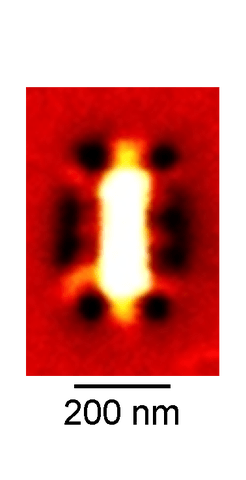Mar 23 2016
Capturing infrared light with graphene-based nanostructures has been demonstrated by scientists from CIC nanoGUNE, in partnership with Graphenea and ICFO. When light combines with graphene’s charge oscillation, the result is a mixture of charge oscillations and light referred to as plasmon, which can be compressed into minute volumes that are millions times smaller than those present in traditional dielectric optical cavities.
 Near-field image of a rectangle graphene nanoresonator. (credit: CIC nanoGUNE)
Near-field image of a rectangle graphene nanoresonator. (credit: CIC nanoGUNE)
The researchers used an advanced near-field microscope to observe this process, which was explained at a theoretical level. Predominantly, two types of plasmons were identified called sheet and edge modes, which propagate either along the edges of the sheet or along the sheet. The edge plasmons have an exclusive ability to direct electromagnetic energy in a single dimension. This research, reported in Nature Photonics, was funded by the EC Graphene Flagship and provides new opportunities for sensors, efficient and ultra-small photodetectors, and other optoelectronic and photonic nanodevices.
Technologies based on graphene help to create very small optical nanodevices. A graphene sheet, which is a single sheet of carbon atoms, reduces the wavelength of light by a factor of 100, compared to light propagating in free space. As a result, the light traveling along the sheet of graphene, known as graphene Plasmon, needs relatively less space. So photonic devices can be developed in extremely smaller formats.
One way to further improve the plasmonic field concentration is to fabricate graphene nanostructures, which act as nanoresonators for the plasmons. This improved field has already been applied for infrared vibrational sensing of molecules, improved terahertz and infrared photodection, etc.
The development of efficient devices based on plasmonic graphene nanoresonators will critically depend on precise understanding and control of the plasmonic modes inside them.
Dr. Pablo Alonso-Gonzalez, Oviedo University.
He used a near-field microscope to carry out real-space imaging of the graphene nanoresonators such as rectangles and disks.
We have been strongly impressed by the diversity of plasmonic contrasts observed in the near-field images.
Dr. Alexey Nikitin, Ikerbasque Research Fellow, nanoGUNE
The individual plasmonic modes were disentangled and separated into two different classes: sheet plasmons and edge plasmons. The sheet plasmons can reside “inside” the graphene-based nanostructures, spanning over the entire area of graphene. In contrast, the edge plasmons exclusively travel along the boundaries of graphene nanostructures, resulting in whispering gallery modes in Fabry-Perot resonances or disk-shaped nanoresonators in graphene nanorectangles, because of the reflection at their edges.
The advantage of edge plasmons over sheet plasmons is that the former is much better confined and transfers the energy in a single dimension. Dipolar edge modes, revealed by the real-space images, have a mode volume which is 100 million times smaller than that of a cube of free-space wavelength.
Due to their unique features, edge plasmons could be a potential platform to combine single molecules or quantum dots in next-generation quantum opto-electronic devices. The dispersion of the edge plasmons on the basis of their near-field images was also measured by the researchers. These near-field images highlight the reduced wavelength of edge plasmons compared to sheet plasmons
Our results also provide novel insights into the physics of near-field microscopy of graphene plasmons, which could be very useful for interpreting near-field images of other light-matter interactions in two-dimensional materials.
Rainer Hillenbrand, Research Professor, Ikerbasque